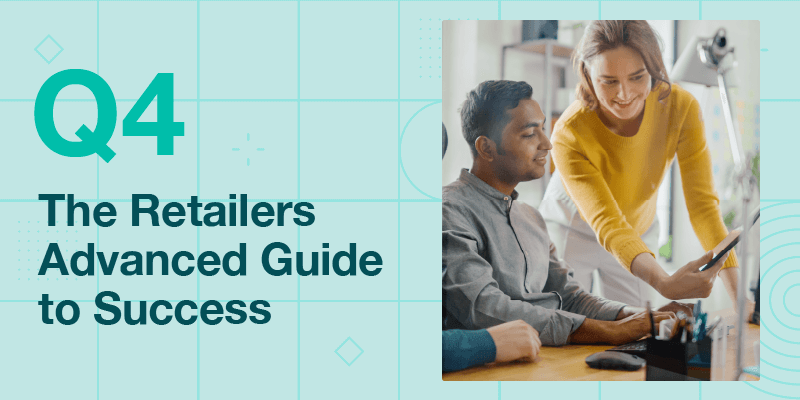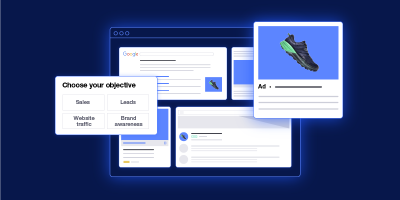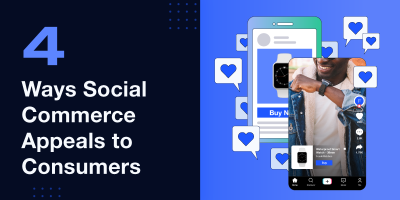Q4 is here. Here are 4 areas where retail brands can strengthen their existing Google Shopping foundation to accelerate growth this holiday season.
1. Smart Bidding Strategies
Google has promoted automated bidding strategies for several years and there is no one-size-fits-all bidding method. These strategies have become more sophisticated and allow you to balance control of your bidding performance while factoring in dozens of different signals built on advanced algorithms.
There are many smart bidding strategies, but there are two worth highlighting for Google Shopping this season—target return on ad spend (ROAS) and maximize clicks.
Target ROAS
Target ROAS assigns values to different conversions and then optimizes bidding to maximize your return. Using your reported conversion values, it can predict future values through conversion tracking. Target ROAS also helps with turnaround time and improves inefficient Google Shopping campaigns.
Tip: Create a log of target ROAS change history as part of your performance and pacing reports for close monitoring over time. And remember to track conversion counts, ensuring campaign types are meeting a minimum of 20 conversions in the past 45 days to ensure the algorithms have sufficient data for bidding decisions. The best practice is to have closer to 50 conversions in the past 30 days.
Maximize Clicks
Maximize clicks automatically sets your bids to help get as many clicks as possible within your budget. This may be worth testing for campaigns that are already limited by budget. It’s also a great tactic to employ if you need to drive users to site, develop some early learnings, or implement a quick campaign launch before switching over to target ROAS for the long term.
Tip: Avoid surprises and remember to monitor maximize clicks closely, set a maximum CPC bid limit, and reconfirm budget thresholds affected by this bid strategy.
Smart bidding strategies like target ROAS or maximize clicks are recommended to scale your efforts this holiday season. Test these approaches and establish benchmarks now to develop the right plan for the season. Target ROAS and maximize clicks also work well with seasonality adjustments, which can give a signal when there is a boost in conversion rates on key dates.
“Smart bidding continues to get smarter and more responsive. It also makes optimizations more streamlined and effective. During the holiday time we believe in leaving the bid optimizations to the algorithms, giving those working on accounts more time to pull in-depth insights and analysis that will drive a more advanced holiday strategy.”
—Courtney O’Donnell, Senior Director of Strategy, Shopping & Feeds at Tinuiti
2. Audience Targeting
The right audiences are also key to success because they help drive more conversions and maximize campaigns for retail brands.
RLSA
Although Remarketing Lists for Search Ads (RLSA) was first released in 2013, it remains a powerful retargeting feature of Adwords. RLSA allows you to target consumers that have previously visited your site, purchased products in the past, or interacted with your business. Conversion rate is higher for these audiences compared to normal users.
Similar Audiences
Targeting similar audiences can also help attract new visitors to your website because they have similar search behavior to your existing remarketing list members. This strategy also helps locate more best-performing users that match past buyers’ online personas, allowing you to simplify audience targeting and gain new customers.
“Remember to set a calendar reminder to check back frequently for new additions that become available under similar audiences based on any newly added audiences. New seasonal shopping audiences are also continually added.”
—Linda Yonemoto, Strategist, Shopping & Feed at Tinuiti
Customer Match
You can also integrate your efforts across channels by leveraging customer match data. Upload your customer lists from your email service provider into Google Ads, complying with all personally identifiable information requirements. Doing so allows you to use your highly targeted advertising lists to upsell, cross-sell, promote repeat purchases from previous customers, target cart abandonments, and re-engage loyal customers.
Affinity and In-Market Audiences
Other audiences available for layering include Google’s affinity and in-market audiences. Affinity audiences are groups placed in predefined buckets of general interest that Google creates based on browsing and search history. In-market audiences are also broader, and include users who have shown intent to compare and purchase a specific category of products. Both benefit branding and awareness by helping to drive quality impressions and a broader reach.
Layering on and testing all these audiences early on verus only using RLSA is key to expanding your overall targeting efforts in the upcoming season. There is no better time than the present.
3. Integrating Your Feed and Marketing Strategies
A strong product feed is essential to success on Google Shopping. Beyond the basics of optimizing your product titles, using keywords in titles & descriptions, and using merchant promotions, selecting a feed partner that has enhanced capabilities matters.
Product Categorization
Feedonomics can help with important but time consuming efforts like Google Shopping categorization, which search engines weigh heavily for relevancy. If categorization is incorrect or too general, a brand is less likely to show in search results. Correct categorization also helps ensure that bidding rules within campaigns are categorized in correct campaigns instead of defaulting to too general “catch-all” buckets.
“We have observed leading retailers with only 60-70% accuracy in new and prospective client audits. With limited time and resources, teams need to consider solutions to help them work smarter, not harder. Digital agencies and brands can reduce their operational overhead by utilizing a platform with intelligent Feed AI that makes categorization much easier and more accurate.”
—Brian Roizen, Co-Founder and Chief Architect at Feedonomics
Custom Labels
Aside from product categorization, another valuable feed attribute for marketing strategy is custom labels. Merchants can create up to five custom labels, numbered 0 through 4, for each item in their feed. Custom labels allow effective bid changes at scale, reducing the cost of sale (COS) and increasing bidding efficiency. Some examples of custom label strategies include:
- Product-based custom labels: color, size, weight, age group, gender
- Price buckets or margin tiers
- Performance-based custom labels: best seller, low conversion, focus products or “push” labels for new products or items you want increased exposure.
“Custom labels tend to be the most underutilized feature of a Google Shopping campaign. If we think about custom labels as a two-way information flow, you can leverage more functionality out of the data than just segmentation. In addition to setting up bids using custom labels, it’s instructive to check the performance of these products to further develop your marketing strategies.”
—Patrick Aubry, Sales Engineer at Feedonomics
Product Ratings and Filtering
Showing Shopping Ads for products with a 5-star rating system and a count of total reviews is another enhanced strategy. A retailer might use a combination of feed rules or custom labels to focus on serving ads for products with 4+ star ratings—which drives higher CTR—and exclude products with a star rating of 3 or less from advertising.
4. Expanding Your Reach
Google has added powerful additions over the years, including Local Inventory Ads (LIAs), which are key for retailers with brick and mortar stores. LIAs are Google Shopping ads that display to nearby shoppers searching on Google. LIAs also include an option for curbside badge messaging. A message that says “pickup today” lets customers know they can get their products quickly via curbside or contactless pickup. This can help improve CTR and conversions. To make your LIAs eligible for store pickup, you need to meet specific criteria and follow special feed requirements.
Beyond Google, there are also options to diversify your marketing investments this holiday season by launching Microsoft Shopping, Connexity, Pinterest, and other feed-based programs to capture audiences that might not be on Google.

Linda Yonemoto is a Strategist and eCommerce Team Lead at Tinuiti, where she guides clients and account management teams on marketing strategy and project management. Prior to joining Tinuiti, Linda led Shopping and Paid Search at Zappos and L.L.Bean.



